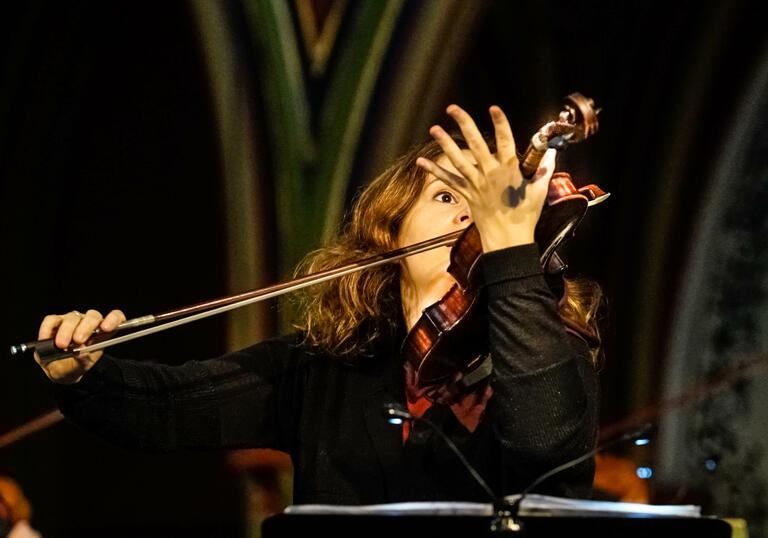
Programme and performers
Gustav Holst ‘Jesu Sweet’ from Four Songs for voice and violin
Walther von der Vogelweide, arr Michi Wiancko Palästinalied
George Crumb ‘God-music’ from Black Angels
Guillaume Dufay, arr Michi Wiancko Ave maris stella
Frank Martin ‘Ave Maria’ from Maria-Triptychon
Tomás Luis Victoria, arr Michi Wiancko Ave Maria
György Kurtág ‘Berceuse’ from Kafka-Fragmente
Anon, arr Wolfgang Katschner Maria durch ein Dornwald ging
Frank Martin ‘Magnificat’ from Maria-Triptychon
Antonio Lotti, arr Michi Wiancko Crucifixus
Lili Boulanger, arr Michi Wiancko Pie Jesu
Hildegard von Bingen O rubor sanguinis
Joseph Haydn ‘Mulier, ecce filius tuus’ from Die sieben letzten Worte unseres Erlösers am Kreuze
György Kurtág ‘Wiederum, wiederum’ from Kafka-Fragmente
Frank Martin ‘Stabat Mater’ from Maria-Triptychon
Hanns Eisler, arr Michi Wiancko ‘Lied der Kupplerin’ from Die Rundköpfe und die Spitzköpfe
György Kurtág ‘Coitus als Bestrafung’ (Canticulum Mariae Magdalenae) from Kafka-Fragmente
PatKop Danse macabre
Joseph Haydn ‘Il Terremoto’ from Die sieben letzten Worte unseres Erlösers am Kreuze
Antonio Caldara ‘Per il mar der pianto mio’ from Maddalena ai piedi di Cristo
Ensemble Resonanz
Patricia Kopatchinskaja violin & concept
Anna Prohaska soprano & concept
Song texts
Jesu Sweet, now will I sing
To Thee a song of love longing;
Do in my heart a quick well spring
Thee to love above all thing.
Jesu Sweet, my dim heart’s gleam
Brighter than the sunnèbeam!
As thou wert born in Bethlehem
Make in me thy lovèdream.
Jesu Sweet, my dark heart’s light
Thou art day withouten night;
Give me strength and eke might
For to loven Thee aright.
Jesu Sweet, well may he be
That in Thy bliss Thyself shall see:
With lovè cords then draw Thou me
That I may come and dwell with Thee.
Meine Seele erhebt den Herrn,
und mein Geist freuet sich Gottes meines Heilandes.
Denn er hat die Niedrigkeit seiner Magd angesehen.
Siehe, von nun an werden mich selig preisen alle Kindeskinder;
denn er hat grosse Dinge an mir getan,
der da mächtig ist und des Name heilig.
Sein Name ist heilig,
und seine Barmherzigkeit währet immer für
und für bei denen die ihn fürchten.
Er übet Gewalt mit seinem Arm
und zerstreuet die hoffärtig sind in ihres Herzens Sinn.
Er stösset die Gewaltigen vom Thron
und erhebt die Niedrigen.
Die Hungrigen füllet er mit Gütern
und lässt die Reichen leer.
Er denket der Barmherzigkeit
und hilft seinem Diener Israel auf,
wie er geredet hat unsern Vätern,
Abraham und seinen Kindern ewiglich.
My soul magnifies the Lord
and my spirit rejoices in God my Saviour
For He has looked on his lowly handmaiden.
Behold, from now on I shall be called blessed by all generations;
for He has done great things unto me,
He who is mighty, and whose name is holy.
His name is holy,
and His mercy lasts for ever
for those who fear Him.
He exercises strength with His arm
and scatters those who are proud in their innermost thoughts.
He unseats the mighty from their thrones
and exalts the lowly.
The hungry he fills with good things
and leaves the rich empty-handed.
He is mindful of his mercy,
and upholds his servant Israel,
As he promised our fathers,
Abraham and his children for ever.
Ach, man sagt, des roten Mondes Anblick
auf dem Wasser macht die Mädchen schwach,
und man spricht von eines Mannes Schönheit,
der ein Weib verfiel: dass ich nicht lach’!
Wo ich Liebe sah und schwache Knie,
war’s beim Anblick von Marie!
Und das ist sehr bemerkenswert.
Gute Mädchen lieben nie
einen Herrn, der nichts verzehrt,
doch sie können innig lieben,
wenn man ihnen was verehrt.
und der Grund ist: Geld macht sinnlich,
wie uns die Erfahrung lehrt.
Und der Grund ist: Geld macht sinnlich,
wie uns die Erfahrung lehrt.
Ach, was soll des roten Mondes Anblick
auf dem Wasser, wenn der Zaster fehlt?
Und was soll da eines Mannes oder Weibes Schönheit,
wenn man knapp ist und es sich verhehlt?
Wo ich Liebe sah und schwache Knie
war’s beim Anblick von Marie!
Und das ist bemerkenswert:
Wie soll er und wie soll sie
sehnsuchtsvoll und unbeschwert
Auf den leeren Magen lieben?
Nein, mein Freund, das ist verkehrt!
Frass macht warm und Geld macht sinnlich,
Wie uns die Erfahrung lehrt.
Frass macht warm und Geld macht sinnlich,
Wie uns die Erfahrung lehrt.
Oh, they say the sight of the red moon
on the water makes young girls grow daft,
and they talk of how a man’s sheer beauty
made a woman faint: Don’t make me laugh!
Though I did once see love go weak at the knee,
when I came across Marie!
Which is very strange – and why?
Because good girls are never sweet
on men who can’t afford to eat,
but they can truly love a guy
who worships them to heaven high.
The reason: money makes you sexy –
the lesson of experience, say I.
The reason: money makes you sexy –
the lesson of experience, say I.
Oh, what good is the sight of the red moon
on the water, when you have no dough?
And what use is a man’s or a woman’s beauty
When they’re skint and trying to hide it so?
Though I did once see love go weak at the knee,
when I came across Marie!
Which is strange: how could they bear to –
How could he and how could she,
Full of longing, without a care – to
make love on an empty stomach?
No, my friend, that makes no sense!
Grub warms you, money makes you sexy:
That’s the lesson of experience.
Grub warms you, money makes you sexy:
That’s the lesson of experience.
Artist biographies
Patricia Kopatchinskaja’s focus is to get to the heart of the music, to its meaning for us – here and now. She brings an inimitable sense of the theatrical to her music-making, whether in core repertoire or original staged projects
This season she joins forces with Herbert Fritsch and visual artist Jannis Varelas to create a Neo-Dada opera production Vergeigt at Theater Basel, has an Artist Spotlight here at the Barbican (which includes tonight’s revival of Maria Mater Meretrix) and takes up the position of Associated Artist with the SWR Experimentalstudio. She also premieres her new project In search of a lost melody, inspired by Ligeti’s music. Further ahead she reunites with longstanding recital partner Fazıl Say for an extensive European tour following the release of their new recording.
Her particular focus is on music of the 20th and 21st centuries and and she has collaborated with composers such as Luca Francesconi, Michael Hersch, György Kurtág, Márton Illés and Esa-Pekka Salonen. She directs staged concerts at venues on both sides of the Atlantic and works with leading orchestras, conductors, and festivals worldwide. Following the international success of her collaboration with the Mahler Chamber Orchestra – Bye Bye Beethoven – she returned for a new concert staging with the ensemble – Les Adieux – a project confronting the rapid deterioration of the environment and the loss of the natural world.
She also performs as a vocal artist in works such as Ligeti’s Mystères du macabre and Schoenberg’s Pierrot lunaire.
Her discography of over 30 recordings includes the Grammy award-winning Death and the Maiden with Saint Paul Chamber Orchestra and, most recently Maria Mater Meretrix with Anna Prohaska (Alpha).
Patricia Kopatchinskaja is a humanitarian ambassador for Terre des Hommes, the leading Swiss child relief agency, and was awarded the Swiss Grand Award for Music by the Federal Office of Culture for Switzerland in 2017.
